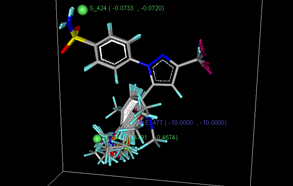| |
|
| Products > VLifeMDS > VLifeQSAR |
|
|
|
|
|
|
VLifeQSAR is a high performance module that enables and drives a ligand based drug design approach. It allows discovery scientists with an unparalleled level of flexibility to choose from multiple options in data selection through model generation. The 2D QSAR and 3D QSAR approaches with VLifeQSAR constitute a complete workflow for either screening molecules from a database or to design new molecules.
With VLifeQSAR, users can calculate a wide variety of descriptors, access multiple methods for data selection, variable selection and either linear or non-linear regression to generate models that are robust and accurate. An intuitive work flow provides a logical and easy to follow sequence for model generation that enables QSAR modeling with just a fundamental understanding of the technique while the choice of options to control and influence the results at each step enable generating models with advanced level insight into the technique. |
| |
 |
| |
1000+ descriptors
VLifeQSAR includes a wide class of descriptors including the unique alignment independent descriptors that allow the user to capture pertinent chemical structure information from their dataset molecules in a most comprehensive way. |
Applicability domain check
The unique applicability domain check function within VLifeQSAR helps to impart confidence on the prediction ability of the QSAR model by verifying that the molecule whose activity is to be predicted is indeed within the applicability domain of the model. |
QSAR modeling
VLifeQSAR provides a wide choice of data selection methods for setting test and training sets and also a unique flexibility to couple any of the variable selection method with any model building method to result in generation of models customized to suit a project requirements. This flexibility allows the user to choose the methods best suited for their dataset and end objectives. The inherent non linearity in the novel kNN MFA regression method produces results that are much more accurate when relating data that is non linear in nature. |
|
|
|
 |
| Ranges of field values for set of steroid molecules using kNN-MFA |
|
|
|
Peer reviewed algorithms
Algorithms in VLifeMDS have wide acceptance in scientific community. These algorithms are either published or are patent pending. There are multiple case studies of research conducted with VLifeMDS. |
Ease of plug-in / plug-out
Although an integrated platform, VLifeMDS has a modular architecture. Customers can buy the whole suite in one-go or buy incrementally as per the evolving needs of their research projects. Incremental module additions seamlessly integrate with rest of the modules to provide a consistent experience. |
Ease of customization & integration
VLifeMDS is developed fully in-house with complete ownership of every line of code. This provides unprecedented flexibility to add-on/ customize the product to suit customer specifications as well as integrating it to customers' existing discovery workbench. |
 |
|
|
|
|
| |
|
 |
Development of dual active antifungals View |
 |
Anti-cancer : Classification model development View |
 |
Pharmacophore identification and lead optimization for novel antifungals View |
|
|
|
|
|
|
|
|
|
|
|
|
|
|
| |
|
|
| LeadGrow |
| Combinatorial library generation |
|
|
|
|
|
|
|
|